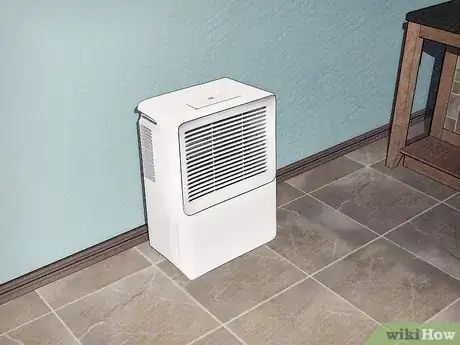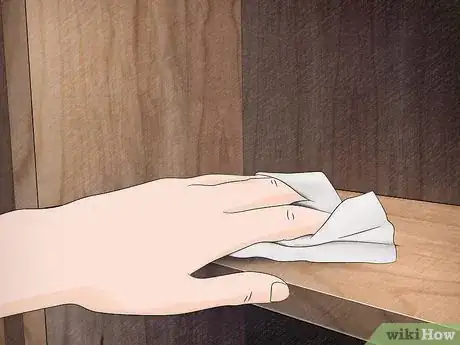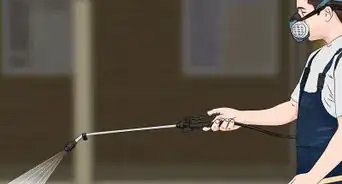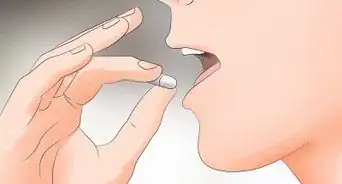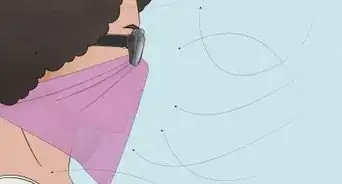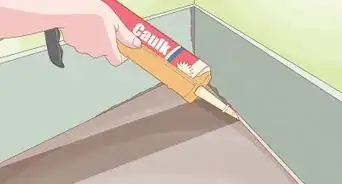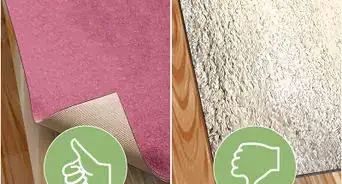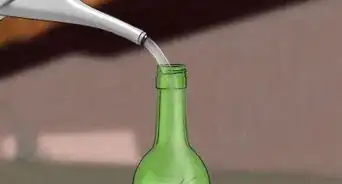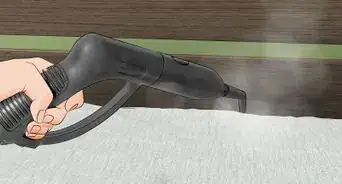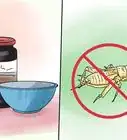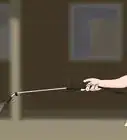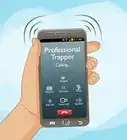This article was co-authored by Chris Parker and by wikiHow staff writer, Amy Bobinger. Chris Parker is the Founder of Parker Eco Pest Control, a sustainable pest control service in Seattle, Washington. With over seven years of experience, Chris specializes in Integrated Pest Management and doesn’t use any chemicals for pest removal. He offers removal services for ants, rodents, fleas, spiders, wasps, and more. Chris is a certified Commercial Pesticide Applicator in Washington State and received his bachelor’s from the University of Washington.
wikiHow marks an article as reader-approved once it receives enough positive feedback. In this case, 92% of readers who voted found the article helpful, earning it our reader-approved status.
This article has been viewed 455,814 times.
The small bugs that are often found in stored books are tiny insects called booklice. These creatures are drawn to areas with high humidity and moisture, and love feeding on mold. Despite the name, booklice aren't only found in books and they aren't actually lice. However, there are methods you can use to get rid of these pests, and the key is controlling the humidity in your home or office.
Steps
Killing Booklice
-
1Identify a booklice infestation. Before trying to get rid of booklice, it’s a good idea to ensure that you actually have them. Otherwise, your attempts to kill them may not work! You can identify booklice by their appearance and by where you find them.
- Booklice are small insects between 0.04 and 0.08 inches (1 and 2 mm) in length. The abdomen makes up the majority of the entire body.[1]
- These insects come in a range of colors, from translucent to white, and from gray to brown.
- Booklice that live indoors do not have wings, but they do have relatively large mouthparts.
- Because booklice feed on mold, they're often found in warm, moist environments, such as near books and papers, under wallpaper, in pantries, and in open food and grain containers.
-
2Remove infested items. One of the simplest ways to get rid of booklice from a home or other space is by throwing out infested items, such as books, boxes, stacks of paper, and food.
- Throw out any contaminated food items that you find, such as old cereal boxes, bags of flour, or grains and other items that aren't airtight.
- To kill booklice on infested items that you don’t want to throw out, seal the items in a plastic bag and place it in the freezer for one to two days. Then remove the bag from the freezer and vacuum the item to get rid of the dead booklice.[2]
Advertisement -
3Kill mold and mildew in the house. Booklice love eating mold, and removing their primary food source is a great way to get rid of them. Mold isn't good for human health, so it’s a good idea for your family and for your infestation to get rid of it.
- Mold grows where there's moisture, such as on food, in bathrooms and kitchens, in laundry rooms, and on paper products.
- When you see visible mold in your house, kill it by scrubbing the area with oxygen bleach, vinegar, or borax.[3]
- There are some items, such as paper and books, that can’t properly be disinfected without destroying the item. Throw out moldy items that can't be cleaned.
-
4Run a dehumidifier. Booklice need moisture to survive, so reducing the humidity in your house will kill them. Set up a few dehumidifiers, especially in damp areas like basements and bathrooms. Run them to remove moisture from the environment.
- To kill booklice, you'll have to get the humidity under 50 percent. Use a hygrometer to measure the humidity.
- Be sure to empty the reservoir on the dehumidifier when it becomes full.
-
5Eliminate water sources. There can be lots of standing water in your house that leads to mold, and removing these will stop the primary food source from growing. To clean up and prevent standing water in your house:
- Fix any leaking or dripping pipes in the house[4]
- Place removable trays under indoor plants to catch excess water
- Clean up spills immediately
- Use mats in front of showers and bathtubs
-
6Improve ventilation. Another way to remove moisture and prevent mold is to increase the ventilation inside. The best ways to do this is by opening windows whenever and wherever possible, and by running ceiling or standing fans to circulate air.[5]
- Ventilation is particularly important in areas that are prone to moisture, such as basements, attics, and bathrooms.
- All bathrooms should be equipped with ceiling fans to remove moisture when showers and tubs are in use.
-
7Use pesticides as a last resort. Although booklice can destroy books, they don’t bite and don’t carry infectious diseases. Because of this, pesticides aren't usually necessary, especially because infestations can usually be controlled by reducing humidity and increasing ventilation. However, if you have a large and uncontrollable infestation, you may want to try a pesticide.
- For house-wide infestations, spray anywhere you’ve seen booklice, in all damp rooms and areas, along the foundation of the house, around window and door frames, and even the cracks and seams in bookshelves and pantries.[6]
- Pesticides you can use include Tri-Die Aerosol, diatomaceous earth, Demand CS, and 565 Plus XLO.[7]
EXPERT TIPChris Parker is the Founder of Parker Eco Pest Control, a sustainable pest control service in Seattle, Washington. With over seven years of experience, Chris specializes in Integrated Pest Management and doesn’t use any chemicals for pest removal. He offers removal services for ants, rodents, fleas, spiders, wasps, and more. Chris is a certified Commercial Pesticide Applicator in Washington State and received his bachelor’s from the University of Washington.Founder, Parker Eco Pest Control
 Chris Parker
Chris Parker
Founder, Parker Eco Pest ControlExpert Warning: Pesticides like demand Demand CS requires you to dilute the solutions using precise measurements, so they're a little complicated for home use. Consult an exterminator before attempting to use strong pesticides on your own.
Cleaning Up After an Infestation
-
1Vacuum. After you’ve removed moisture and mold, and increased ventilation, you'll likely have a number of dead booklice bodies lying around. To clean them up, simply vacuum the entire house. Be sure to use nozzle and brush attachments to get into nooks and crannies in areas where booklice were living.
- For a booklice infestation around books, remove the books from the shelves and vacuum the covers, bindings, and pages.
- If you don’t have a vacuum, dust furniture, shelves, and other areas, and then sweep the floors thoroughly.
-
2Wipe down areas where booklice were present. When all the books are off the shelves, clean the shelves with your favorite household cleaner. If you had booklice in the kitchen, remove all the food items from the cupboards and clean out the pantry with an all-purpose cleaner.
- Let cupboards, shelves, and pantries dry completely over several hours before returning items to their proper places.[8]
-
3Throw out paper products you don’t need. Paper products can mold easily, especially in high-humidity environments. To ensure that you’ve removed the entire booklice infestation and possible food sources, throw out mold-prone items that you don’t need and don’t use.
- Paper products include things like printer and writing paper, letters, books, old newspapers and magazines, and even boxes and cardboard.[9]
Preventing Booklice
-
1Store books and boxes properly. To prevent books, paper, and boxes from growing mold, keep them in a dry environment. Also, store them off the ground whenever possible.[10]
- Books should always be kept on shelves rather than stacked on the floor.
- If you have a lot of items stored in boxes, store the boxes on shelves when possible, or build platforms to keep them off the ground.
-
2Clean spills and puddles immediately. A bit of water spilled on the ground may not seem like a big deal, but it can actually lead to mold growth in the right environment, especially if it happens frequently. Cleaning spills includes when you:
- Spill a drink
- Slosh water out of the sink when doing dishes
- Drip water when getting out of the bath or shower
- Experience a pipe burst or leak
-
3Keep food airtight. Booklice don’t actually eat the food in your cupboards, but they will feed on mold and fungi that grow on that food. To prevent early spoilage and a booklice infestation, transfer all dry food items to airtight containers after opening. This includes:[11]
- Breads
- Cereals
- Beans and grains
- Flours, sugars, and other baking supplies
- Cookies and crackers
-
4Control the humidity and ventilation inside. Even after the booklice infestation has been taken care of, you should still maintain the humidity in your house to prevent mold and stop a future infestation.[12]
- Leave a dehumidifier running in the dampest rooms in your house year round.
- Open windows as often as possible, and use fans to circulate air in the house.
Expert Q&A
-
QuestionCan booklice live on humans?
 Kevin CarrilloKevin Carrillo is a Pest Control Specialist and the Senior Project Manager for MMPC, a pest control service and certified Minority-owned Business Enterprise (MBE) based in the New York City area. MMPC is certified by the industry’s leading codes and practices, including the National Pest Management Association (NPMA), QualityPro, GreenPro, and The New York Pest Management Association (NYPMA). MMPC's work has been featured in CNN, NPR, and ABC News.
Kevin CarrilloKevin Carrillo is a Pest Control Specialist and the Senior Project Manager for MMPC, a pest control service and certified Minority-owned Business Enterprise (MBE) based in the New York City area. MMPC is certified by the industry’s leading codes and practices, including the National Pest Management Association (NPMA), QualityPro, GreenPro, and The New York Pest Management Association (NYPMA). MMPC's work has been featured in CNN, NPR, and ABC News.
MMPC, Pest Control Specialist Booklice are not actually related to head or body lice and cannot live on humans.
Booklice are not actually related to head or body lice and cannot live on humans. -
QuestionWhat do booklice feed on?
 Kevin CarrilloKevin Carrillo is a Pest Control Specialist and the Senior Project Manager for MMPC, a pest control service and certified Minority-owned Business Enterprise (MBE) based in the New York City area. MMPC is certified by the industry’s leading codes and practices, including the National Pest Management Association (NPMA), QualityPro, GreenPro, and The New York Pest Management Association (NYPMA). MMPC's work has been featured in CNN, NPR, and ABC News.
Kevin CarrilloKevin Carrillo is a Pest Control Specialist and the Senior Project Manager for MMPC, a pest control service and certified Minority-owned Business Enterprise (MBE) based in the New York City area. MMPC is certified by the industry’s leading codes and practices, including the National Pest Management Association (NPMA), QualityPro, GreenPro, and The New York Pest Management Association (NYPMA). MMPC's work has been featured in CNN, NPR, and ABC News.
MMPC, Pest Control Specialist Booklice typically feed on mold, though they sometimes can also feed on starch-based pastes used in book bindings or wallpaper.
Booklice typically feed on mold, though they sometimes can also feed on starch-based pastes used in book bindings or wallpaper. -
QuestionWhat is an easy home remedy for book lice?
 Chris ParkerChris Parker is the Founder of Parker Eco Pest Control, a sustainable pest control service in Seattle, Washington. With over seven years of experience, Chris specializes in Integrated Pest Management and doesn’t use any chemicals for pest removal. He offers removal services for ants, rodents, fleas, spiders, wasps, and more. Chris is a certified Commercial Pesticide Applicator in Washington State and received his bachelor’s from the University of Washington.
Chris ParkerChris Parker is the Founder of Parker Eco Pest Control, a sustainable pest control service in Seattle, Washington. With over seven years of experience, Chris specializes in Integrated Pest Management and doesn’t use any chemicals for pest removal. He offers removal services for ants, rodents, fleas, spiders, wasps, and more. Chris is a certified Commercial Pesticide Applicator in Washington State and received his bachelor’s from the University of Washington.
Founder, Parker Eco Pest Control You can place a bag or a jar filled with a desiccant, like the packets of silica gel found in food containers, around your house.
You can place a bag or a jar filled with a desiccant, like the packets of silica gel found in food containers, around your house.
References
- ↑ http://www.orkincanada.ca/pests/booklice/
- ↑ http://www.kiwicare.co.nz/help/problem/?sid=booklice
- ↑ http://blacktoxicmolds.com/bleach-kill-mold.php
- ↑ https://www.rottler.com/blog/post/how-to-get-rid-of-booklice
- ↑ http://www.bpca.org.uk/pages/?page_id=152
- ↑ http://www.kiwicare.co.nz/help/problem/?sid=booklice
- ↑ http://www.asktheexterminator.com/Household_Pests/Psocids.shtml/
- ↑ http://www.kiwicare.co.nz/help/problem/?sid=booklice
- ↑ https://www.rottler.com/blog/post/how-to-get-rid-of-booklice
About This Article
To get rid of booklice, start by throwing out any items that show signs of lice infestation, like books or boxes. If you wish to keep any of the infested items, wrap them in a plastic bag, put them in your freezer for 2 days to kill the lice, and then vacuum the dead booklice off of items. Additionally, search your home for evidence of mold or mildew, which is the primary food source for booklice, and spray the affected areas with vinegar or bleach to get rid of it. Booklice need moisture to survive, so it also helps to run a dehumidifier in damp areas like the basement and mop up any standing water near leaky pipes or drains. To learn how to prevent booklice, keep reading!



